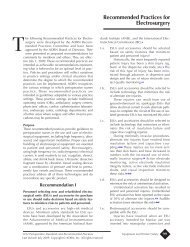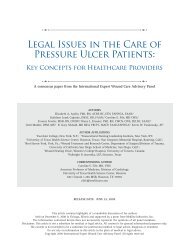2009 CAUTI guidelines - Centers for Disease Control and Prevention
2009 CAUTI guidelines - Centers for Disease Control and Prevention
2009 CAUTI guidelines - Centers for Disease Control and Prevention
Create successful ePaper yourself
Turn your PDF publications into a flip-book with our unique Google optimized e-Paper software.
Development of Key QuestionsWe first conducted an electronic search of the National Guideline Clearinghouse® (Agency <strong>for</strong>Healthcare Research <strong>and</strong> Quality), Medline® (National Library of Medicine) using the Ovid®Plat<strong>for</strong>m (Ovid Technologies, Wolters Kluwer, New York, NY), the Cochrane® HealthTechnology Assessment Database (Cochrane Collaboration, Ox<strong>for</strong>d, UK), the NIH ConsensusDevelopment Program, <strong>and</strong> the United States Preventive Services Task Force database <strong>for</strong>existing national <strong>and</strong> international <strong>guidelines</strong> relevant to <strong>CAUTI</strong>. The strategy used <strong>for</strong> theguideline search <strong>and</strong> the search results can be found in Appendix 1A. A preliminary list of keyquestions was developed from a review of the relevant <strong>guidelines</strong> identified in the search. 1,35,36Key questions were finalized after vetting them with a panel of content experts <strong>and</strong> HICPACmembers.Literature SearchFollowing the development of the key questions, search terms were developed <strong>for</strong> identifyingliterature relevant to the key questions. For the purposes of quality assurance, we comparedthese terms to those used in relevant seminal studies <strong>and</strong> <strong>guidelines</strong>. These search terms werethen incorporated into search strategies <strong>for</strong> the relevant electronic databases. Searches wereper<strong>for</strong>med in Medline® (National Library of Medicine) using the Ovid® Plat<strong>for</strong>m (OvidTechnologies, Wolters Kluwer, New York, NY), EMBASE® (Elsevier BV, Amsterdam,Netherl<strong>and</strong>s), CINAHL® (Ebsco Publishing, Ipswich, MA) <strong>and</strong> Cochrane® (CochraneCollaboration, Ox<strong>for</strong>d, UK) (all databases were searched in July 2007), <strong>and</strong> the resultingreferences were imported into a reference manager, where duplicates were resolved. ForCochrane reviews ultimately included in our guideline, we checked <strong>for</strong> updates in July 2008.The detailed search strategy used <strong>for</strong> identifying primary literature <strong>and</strong> the results of the searchcan be found in Appendix 1B.Study SelectionTitles <strong>and</strong> abstracts from references were screened by a single author (C.V.G, R.K.A., orD.A.P.) <strong>and</strong> the full text articles were retrieved if they were 1) relevant to one or more keyquestions, 2) primary analytic research, systematic reviews or meta-analyses, <strong>and</strong> 3) written inEnglish. Likewise, the full-text articles were screened by a single author (C.V.G. or D.A.P.) usingthe same criteria, <strong>and</strong> included studies underwent a second review <strong>for</strong> inclusion by anotherauthor (R.K.A.). Disagreements were resolved by the remaining authors. The results of thisprocess are depicted in Figure 2.27
















